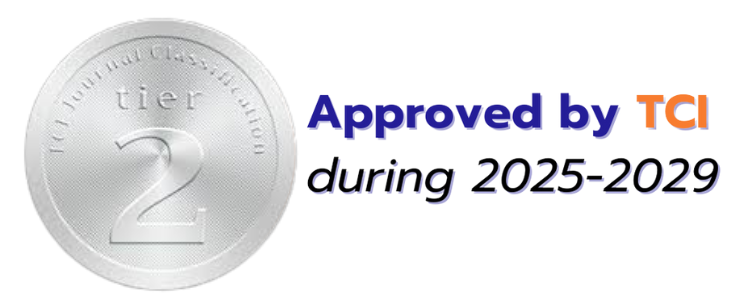Forensic Investigation Context-Based Learning to Enhance Scientific Explanation Ability in Genetics for Grade 9 Students
Keywords:
Context-Based Learning, Scientific Explanation Ability, GeneticsAbstract
.This research aimed to 1) compare ninth grade students' learning achievement in genetics before and after learning through a forensic investigation context-based learning, 2) compare students' scientific explanation ability in genetics with the 80 percent criterion, and 3) examine students' satisfaction with this learning approach. This study employed a quasi-experimental one group pretest-posttest design. The sample consisted of 36 ninth grade students. The research instruments included 1) learning activities using forensic investigation context-based learning (comprising 3 contexts related to genetics), 2) a genetics achievement test, 3) a scientific explanation ability test, and 4) a satisfaction questionnaire. The results showed that 1) students’ post-test mean score on genetics achievement was significantly higher than the pre-test score at the .01 level. 2) The mean score of students' scientific explanation ability in genetics was significantly higher than 80 percent criterion at the .01 level. 3) Students’ satisfaction with the forensic investigation context-based learning was at a high level. This research revealed that forensic investigation context-based learning can enhance content understanding and application of content to explain contexts by emphasing the identification of related claim, evidence, scientific reasoning.
Downloads
References
Allen, J., & Rogers, M. P. (2015). Putting ideas on paper: Formulating scientific explanations using the claim, evidence, and reasoning (CER) framework. Science and Children, 53(3), 32–37.
Bennett, J. (2005). Teaching and learning science: A guide to recent research and its applications. Continuum.
Bennett, J., Lubben, F., & Hogarth, S. (2007). Bringing science to life: A synthesis of the research evidence on the effects of context‐based and STS approaches to science teaching. Science Education, 91(3), 347–370. https://doi.org/10.1002/sce.20186
Choi, K., & Lee, H. (2008). Science education in South Korea: Advances in achievement and future challenges. Journal of Science Education and Technology, 17(2), 125–132. https://doi.org/10.1007/s10956-008-9097-0
Gilbert, J. K. (2006). On the nature of “context” in chemical education. International Journal of Science Education, 28(9), 957–976. https://doi.org/10.1080/09500690600702470
Institute for the Promotion of Teaching Science and Technology. (2019a). Guidelines for teaching and learning to develop scientific literacy in the 21st century. Ministry of Education of Thailand. https://www.ipst.ac.th/ipsten
Institute for the Promotion of Teaching Science and Technology. (2019b). Scientific literacy. https://www.ipst.ac.th/news/12216/20210527_project14.html
Keeley, J., Zayac, R., & Correia, C. (2008). Curvilinear relationships between statistics anxiety and performance among undergraduate students: Evidence for optimal anxiety. Statistics Education Research Journal, 7(1), 4–15. https://iaseweb.org/documents/SERJ/SERJ7(1)
_Keeley.pdf
King, D., & Ritchie, S. M. (2012). Learning science through real-world contexts. In B. J. Fraser, K. G. Tobin, & C. J. McRobbie (Eds.), Second international handbook of science education. Springer. https://doi.org/10.1007/978-1-4020-9041-7_6
Kruengthong, T. (2010). Context-based learning in science education: A review of theoretical perspectives and applications in classrooms. IPST Magazine, 38(166), 56-59. [In Thai]
Kuhn, L., & Reiser, B. (2005, April). Students constructing and defending evidence-based scientific explanations. Paper presented at the Annual Meeting of the National Association for Research in Science Teaching, Dallas, TX.
McNeill, K. L., & Krajcik, J. (2008). Scientific explanations: Characterizing and evaluating the effects of teachers' instructional practices on student learning. Journal of Research in Science Teaching, 45(1), 53–78. https://doi.org/10.1002/tea.20201
McNeill, K. L., & Krajcik, J. S. (2011). Supporting grade 5–8 students in constructing explanations in science: The claim, evidence, and reasoning framework for talk and writing. Pearson.
Office of the Basic Education Commission. (2022). The assessment of Thai students' scientific competency based on the Programme for International Student Assessment (PISA). Ministry of Education of Thailand. https://www.pisacenterobec.org/about-me/
Organisation for Economic Co-operation and Development (OECD). (2019). PISA 2018 results. OECD Publishing. https://doi.org/10.1787/5f07c754-en
Parchmann, I., Gräsel, C., Baer, A., Nentwig, P., Demuth, R., & Ralle, B. (2006). Chemie im Kontext: A symbiotic implementation of a context‐based teaching and learning approach. International Journal of Science Education, 28(9), 1041–1062. https://doi.org/10.1080/09500690600563534
Wannagatesiri, T., Fakcharoenphol, W., Laohammanee, K., & Ramsiri, R. (2017). Implication of Context-based Science in Middle School Students: Case of Learning Heat. International Journal of Science, Mathematics and Technology Learning, 24(2), 1-19.
Downloads
Published
Issue
Section
License
Copyright (c) 2025 วารสารศาสตร์การศึกษาและการพัฒนามนุษย์

This work is licensed under a Creative Commons Attribution-NonCommercial-NoDerivatives 4.0 International License.







